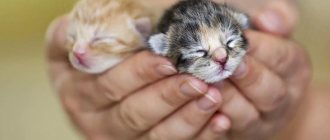What will you learn from the article?
- Preparing the house
- First acquaintance - how to introduce cats What felinologists advise
- Cat and cat
- Cat and kitten
- Cat and kitten
- Causes of aggression
Cats are solitary predators, territorially dependent creatures. It is important for them to have their own place to rest, sleep, eat, use the toilet, hunt and observe the world around them. Therefore, when another pet appears in the house, this inevitably provokes a conflict with the old-timers. How to make friends with cats so that they live peacefully is the main question that needs to be resolved.
In this article you will learn how to introduce pets, how to accustom cats to each other, what you need to do to avoid conflict between animals.
Should you get a second cat?
You can get a second cat only when the owners lack one animal in the house.
If you have free time and enough finances, then why not? But getting a second cat just because the first cat is bored alone is hardly reasonable. Cats are not pack animals, they do not need company (human attention is a separate issue; cats need it no less than dogs). But if the owners have very little free time, the house is empty all day, then you can get a second cat so that the first one does not get bored without communication. Important:
sometimes, despite the competent behavior of the owner, cats cannot be reconciled with each other. Animals, being in constant stress, begin to get sick (both physically and mentally). In this situation, one of the animals will need to be placed in good hands - the family must be mentally prepared for such a development of events.
Friendship
The most favorable development of the situation, except in the case where animals grow up together from a very young age, is the immediate sympathy that arises between them. This happens when a kitten appears in a house with an adult cat. And then the owners do not have to think about how to make friends between a cat and a kitten, since thanks to maternal instinct, a cat is extremely rarely aggressive towards the baby. On the contrary, she, as a rule, takes him under her wing.
But if a kitten is purchased for a home with an adult cat, then there is a chance that at first the old-timer will ignore the newcomer. But later, a warm and strong friendship can also begin between them.
Preparing for a second cat
Before a second cat appears in the house, you need to prepare the space by dividing it into several zones. Two cats in the house will get along much faster if they do not collide with each other in the resting, feeding and toilet areas.
Rest
The “new” cat should sleep separately from the “old” one, and preferably in a different room. The place where an old-timer relaxes is taboo for a newcomer. Be sure to prepare a comfortable mattress or house that will be located at some distance from your cat’s “bedroom”. It is advisable that there be a door between the seating areas that will need to be closed at night (at least for the first time).
Feeding
Two cats that don’t know each other well and have not yet established contact will most likely be most aggressive near food bowls. Therefore, the new cat needs to be fed from a separate dish, preferably not in the room where the “old” cat is used to eating. Over time, if the cats get along, the bowls can be moved. Cats need to be fed at the same time so that each is busy with its own bowl and does not try to take food from its rival.
Toilet
Be sure to buy a separate litter box for the “new” cat. The filler in the old tray should be dirty by the time the new one arrives. So the likelihood that the “new” cat will go into a clean litter box is higher (if the second cat soils the litter box first, a conflict may arise; the first cat may compromise cleanliness and start dirtying the corners). Over time, if the cats become friends, you can leave one tray.
The second cat should be placed so as not to disturb the old-timer. For your first cat, everything should remain the same. In no case should she feel violated in her rights due to the appearance of another animal in the house.
Does a British cat not sit on your hands because of its origin?
I will lie anywhere, but not sit in your arms
Perhaps the British dislike for excessive affection lies in the history of the origin of this breed. There are several versions about this:
- Large gray cats with amber eyes were brought to the British Isles by the ancient Romans.
- French sailors acquired huge gray cats from the monks of Grand Chartres to protect food cargo on ships from rodents. Their ships regularly visited the shores of Britain. Therefore, some cats could remain on the shore.
- The breed of British cats with wide cheekbones, large expressive eyes and thick short hair was formed as a result of crossing immigrants with local tabby wild cats.
Independent character of British cats
British cats have their own, independent and different character
Judging by the history of the origin of this breed, it can be argued that the independent character of the British comes from the harsh life on French ships, where none of the sailors coddled with them. Life among ascetic monks and proud Romans also left its mark on the independent character of these cats.
For centuries, their role was to live among people, mind their own business and earn their basic food.
Wild cat Tabby
Characteristics of a British cat
British cats are distinguished by their intelligence and intelligence. If handled skillfully, they can even be trained. However, adapting their behavior to the mood of their owner, representatives of this breed under no circumstances lose their dignity.
For these cats, freedom and independence are a priority
These qualities are more developed in British cats than others. Despite the centuries-old history of the existence of this breed next to man, the animals did not completely submit to his authority. In many cases, the opposite happens: the cat inevitably dictates terms to its owner.
Royal manners
The British woman even lies like a king
British cats have real royal manners. Restrained by nature, they will not do what they do not consider necessary. All this does not mean that the British are too arrogant and prim. They love and appreciate affection, but accept it in their characteristic independent manner.
Cats of this breed are ideal for business people who are away at work from morning to evening, or even leave home for several days.
These cats demonstrate their affection when meeting their owner. Adhering to aristocratic manners, British cats will not get in the way, but will follow their owner around the house with dignity. They will happily play with the owner's children, lie next to them while watching the evening news, and allow themselves to be petted.
However, you shouldn't relax. The cat will not sit on your lap. And if you try to pick him up and force him to sit with you, it will lead to nothing. British cats do not tolerate familiarity. Therefore, they will gallantly dodge and, without unnecessary emotions, retire in English to where no one will disturb them.
Introducing cats to each other
One of the important factors influencing the development of relationships between cats is the moment of acquaintance. Many owners, not knowing how to make two cats friends, make a number of serious mistakes: they push the cats nose to nose, lock them in one room, or immediately separate them into different rooms, without giving the animals the opportunity to communicate. In the first case, a fight will most likely occur. In the second case, a fight is inevitable and, probably, it will be a serious battle with bloodshed, since the animals do not have the opportunity to retreat. In the third case, gradually increasing tension and anxiety, as a rule, again ends in a fight.
So, first, we give both cats a manicure - trim their claws short and file the sharp edges. A new homeowner can have a manicure done at the breeder's house or even at the entrance (if the kitten was brought from the street).
Advice:
It’s great if it’s possible to mix the smells of two animals before the “new” cat arrives in the house. This is easy to do: iron each cat alternately with a dry terry towel. Pay special attention to the genitals, paws and cheeks.
You need to bring your cat into the house in a carrier or in a closed box with holes cut out for viewing. Open all the doors in the apartment so that one of the cats can escape from the attacker if a fight breaks out. But the windows need to be closed. Place the carrier in the hallway and do not take the cat out for a while - let the old-timer sniff the box, get used to the smell, and come to her senses after the first shock.
After a while, open the carrier, but do not take the cat out of it - let her decide when to go out. Some cats immediately go to explore the territory, others may not stick their nose out of the “shelter” for hours - be patient.
When the cat comes out, the old-timer will most likely begin to demonstrate its dominance and defend its territory. The cat will hiss, stare intently at the uninvited guest, fluff up its fur, and “growl” threateningly. The new resident will most likely adopt a “I don’t care” pose and look, averting his eyes and trying not to look at the aggressor. With this behavior, the cat shows that it does not want conflict. Owners should take on the role of observers during this time and not intervene until a serious fight breaks out. Single lunges, paw strikes, pounces are the norm. You shouldn’t get between cats, as you will only delay the moment of sorting out the relationship. And the faster the cats decide who is boss in the house, the faster peace and friendship will come to your family.
If both cats take a threatening pose, growl, and look intently into each other’s eyes, be on the lookout! This means, but neither animal wants to give in, and both are ready to fight. This condition can last for a very long time, even several hours. If it is not possible to observe, separate the cats into different rooms. It is the new resident who needs to be isolated, otherwise the old resident will feel that he has lost part of the territory, and this will anger him even more.
Possible behavior options for pets
The first meeting of animals can be completely unexpected. We can assume several options for their behavior. These include the following situations.
Friendship
During the first “acquaintance”, pets can sniff each other, which will indicate their sympathy. Then, after some time, they will begin to play, without any special “pretensions” to be in the same room, without paying any attention to their “neighbor”. This behavior is considered the best outcome for adding a second cat to the family.
Anxiety
Quite often, a pet already living in a family begins to get scared and hide from the “uninvited” guest. A cat or cat can hide in a corner, crawl under a bed or sofa and not come out of its hiding place until the object of the “threat”, that is, the new animal, disappears.
Dislike
The spirit of competition is typical for every cat. This behavior is inherent in nature at the genetic level. It also happens that both pets will feel deprived and offended. Each of them will begin to aggressively hiss at the other, showing their displeasure with their entire appearance.
What to do when cats fight?
If cats rush at each other and immediately jump back, hit each other with their paws, but obviously do not cause wounds (warning blows - a series of short waves of the paw), or chase each other around the apartment - do not interfere, just watch. But when a serious fight breaks out, the cats grapple and roll head over heels on the floor, or one of the cats falls on its back, defending itself from the aggressor with its claws, you need to separate the animals.
Under no circumstances should you separate cats with your hands! In the heat of battle, even the sweetest domestic cat can cling so fiercely to the face of its beloved owner that it is impossible to tear it away (redirected aggression). The most effective way is to pour water on the cats. It is advisable to hit the head. Don't be afraid, even if water gets into your ears, nothing bad will happen. If this does not help, throw a heavy, dense cloth (blanket or sheepskin coat) over the fighters. The sudden darkness will frighten the animals - the cats will press themselves to the floor in surprise. After a few seconds, you can remove the blanket, pick up one of the cats (which will seem less aggressive) and take it to another room. If surprise does not help, and the cats are fighting, not paying attention to the darkness, force will help - take a long stick (for example, a mop) and crucify the cats in the corners. You need to act assertively, but carefully! Cats cannot be hit, they only need to be pushed away from each other.
Fighting cats are temporarily placed in different rooms (for a couple of days), and then the attempt at acquaintance is repeated. And so on until the aggression dries up and the animals begin to treat each other more calmly.
Important:
Be sure to contact a veterinary clinic or call a veterinarian at home if one of the cats was seriously injured in a fight. Treat minor scratches with any antiseptic.
How to make friends with cats?
Two cats in the house is not a bad option. Cats do not often defend their territory unless one of them is currently pregnant or nursing kittens. In nature, cats occupy a small area of land (compared to cats) and react more calmly to the presence of strangers. The situation becomes more complicated if one of the cats has already reached adulthood (about 7 years old) or has been the only pet all its life.
Most often, one of the cats occupies a dominant position, and the other tacitly agrees to the “second role.” A dangerous moment arises when one of the cats goes through the heat period.
Sometimes cats seem to get along well with each other, and then one suddenly kills the newborn kittens of a competitor. By cat standards, this is quite normal behavior. When raising kittens, only their mother can be allowed to see the babies, and the other cat must be isolated. However, if the “not mother” has accepted the kittens, you see that she gently licks them and cleans up their feces, and the mother cat calmly reacts to the presence of the “not mother” in the nest, you don’t have to worry about the kittens.
But how to make friends with adult cats if none of them wants to give up their place as the head of the family? This happens infrequently, but this scenario is the most unfavorable. Cats fight desperately, to the last. In such a situation, it would be wise to sterilize both pets, since it is almost impossible to reconcile cats that hate each other. After sterilization, cats will lose aggression associated with sexual instincts - the chance for normal, calm relationships increases.
Puberty in the British
Active puberty of British breed cats begins at the age of 8-10 months. It is at this age that cats begin to walk and ask for a cat.
It is recommended to breed British cats after 1 year, when the body is fully formed to the required degree.
A British cat is in heat
On average, the first heat in cats of the British breed begins at the age of 7-9 months. However, it is impossible to determine the exact period; it all depends on the individual genetics of the British woman, the conditions of her keeping and feeding. In addition, premature estrus can be caused by an adult uncastrated cat with its “calls” if it is somewhere nearby.
The duration of one heat is 8-10 days, the first – 4-5 days. The break between them usually lasts about 20 days, but again it all depends on the hormonal level of the animal.
You can determine when a British cat is in heat by the following signs:
- frequent loud meowing and purring;
- changes in gait (the cat coquettishly bends its knees);
- friction against various objects and the owner’s legs;
- rolling on the floor;
- a sharp change in character;
- demand for increased attention to one’s person.
So the British woman starts asking for a cat. You can help your cat in one of the following ways:
- Let go for a walk;
- Give sedative drops;
- Sterilize.
Mating of British breed cats
Crossbreeding of British cats is recommended at the age of 1 to 2 years. The first mating of a British breed cat up to a year old can lead to an interrupted birth process or even death, and cats can lose the ability to reproduce by the age of 2 years. Therefore, it is recommended to skip the first 2 heats of a British female. However, mating should not be delayed too much - after 2 years, the cat may become so aggressive that it will not allow the cat to come near it.
In most cases, the cat is brought to the cat on the 2nd day of estrus and left for 2-3 days. Remember that officially the British cat breed does not allow mating with other breeds, so if you want purebred kittens, breed only straight-eared British cats.
If your cat doesn't get pregnant the first time, don't despair, just wait for the next heat and try again.
cat and cat
Two mature cats in one house are a constant headache, because... These animals very rarely treat each other calmly. In nature, the territory of cats is much larger than the territory of cats, overlapping several habitats of females. The more such areas a cat enters his territory, the more females he fertilizes. Therefore, cats have much stronger territorial claims than cats, because we are no longer just talking about hunting, but about procreation.
Two adult cats can remain neutral for some time, periodically starting violent fights. In such a fight, cats find out which of them is more important and try to remove a competitor from their territory. Passions run high when there is a mating cat nearby. Fights during this period result in serious injuries and sometimes the death of one of the animals. Often cats begin to mark their territory, constantly overlapping each other’s marks - the smell in such an apartment is overwhelming. Therefore, when you decide to get a second cat, immediately prepare for castration of both animals. And it’s better to do this a couple of months before you meet (which, unfortunately, is not always possible).
Features of cat relationships
nnnrn(adsbygoogle = window.adsbygoogle || []).push({});rn
The question of whether it is necessary to have two or more purrs in the house is of an exclusively individual nature. Someone is jealous of the animal towards family members and wants their own personal bundle of fluffy happiness (often pets only like women, men, or one specific person). Many owners have succumbed to the charm of cats so much that they simply can no longer limit themselves to one pupil.
There are times when a second tenant is brought in so that the first one does not feel bored and lonely. Given the extreme self-sufficiency of four-legged animals, the need for the company of representatives of their own species is questionable. Of course, such a solution may be advisable if the pet is forced to live almost completely alone. However, it sometimes takes a very long time for two proud people to get along.
Careful selection of a new family member will help increase the chances of further peaceful coexistence. According to research by animal psychologists, relationships between pets depend not only on their temperament, but also on gender and age differences:
- two kittens together will find a common language more easily due to the lack of full socialization and undeveloped territorial instincts;
- Individuals of different sexes can make friends without any problems. However, in this case, it is necessary to make a decision on surgical intervention in the reproductive system of at least one of the pets, if the plans do not include further lambing;
- Adult purrs of the same sex often find it difficult to share territory with each other. This is especially true for uncastrated cats, clashes between which can end in bloodshed;
- older pets are wary of kittens - the latter's active games can irritate old-timers. In addition, an animal accustomed to the undivided attention of its owner may become angry and begin to play dirty tricks on the baby;
- if the cub is brought into a house where a sexually mature, and especially pregnant, female lives, the situation can develop in several directions: in the first case, the expectant mother will take custody of the new pet, and in the second, she will refuse to accept it, seeing in the kitten a threat and a competitor for of their offspring.
The best Baby 11 months old, acne on face
It is worth noting that older cats do not always occupy a higher hierarchical position. If they have a gentle disposition, then they can quite easily give in to a young neighbor with a more active and strong character.
Video “How to get along with two cats”
The video discusses the issues of keeping several cats in one house.
How to make friends between a cat and a cat?
Animals of different sexes, as a rule, easily get along with each other. In many cases, neutrality develops into friendship and affectionate relationships. However, at first, most likely, the cat will often “educate” the cat - warning blows, hissing, expulsion from the rest area. It is especially important to feed such animals separately - the cat often leaves nothing for the cat, eating all the food simply to prove its leading position. As a result, the cat receives extra calories, and the cat remains hungry.
If we are not talking about breeding producers, one of the animals must be castrated. Cats are quite fertile, the period of “hunting” is not accompanied by discharge (as in dogs), and the cat is very inventive in its desire to get to the female who is in “hunt”. Therefore, simply separating the animals for a time in order to prevent fertilization is unlikely to succeed (either the owner will miss the deadline, or the cat will still get to the female). But even if you put a cat in a cage, the problem is only partially solved - crazy screams and constant marks can unsettle the most patient owner. In addition, the neighbors are unlikely to tolerate round-the-clock yelling, and they will be right. And for animals, it is very difficult to endure such stress - the consequences will certainly affect the health of both pets. We don’t even have to talk about constant pregnancy and childbirth - not a single cat can withstand such stress.
Common Mistakes
Inexperienced owners often do not know what to do in a given situation, which leads to the following mistakes:
- Poor nutrition: if everyone eats at the same time and nearby, then someone will inevitably try to steal food from someone else’s plate.
- Uncontrolled first meeting: some let the cat and dog communicate freely, not thinking that this could develop into a fight.
- Lack of separate resting places: cats are introverts by nature. Long communication will infuriate the pet and can lead to aggression. It is advisable to give the cat its place on a hill.
- Playing off animals: they will remember a fight that happens once for the rest of their stay, so clashes should not be allowed.
How to make friends between a cat and a kitten?
A cat and a kitten are the best option (unless you take into account the situation when two small kittens grow up together). The cat either immediately accepts the kitten, taking on the role of its mother and teacher, or remains neutral. Cats rarely show open aggression towards kittens. Yes, they can quite rudely confront an annoying fidget, but they don’t carry out serious beatings. However, it is important to consider that a kitten is a baby aged 2-3 months. A six-month-old animal looks like a kitten only to people - for a cat it is already a teenager who can pose a danger, which means that you already need to protect yourself from it with all four paws.
As the baby grows up, the relationship between cat and kitten will reach a new level. The animals will either become very friendly, or one of the cats will take a dominant position (the details are described above: cat and cat, cat and cat, cat and cat).
A few words about breeds
Representatives of different breeds of cats can have very different personalities.
This fact is also worth paying attention to when choosing a new pet.
British shorthair cats and ragdolls have the most flexible character. Phlegmatic Britons usually find it easy to get along with most animals. Ragdolls get along well with representatives of any calm breeds, but can experience severe stress from being around active and assertive pets.
Persian cats can be more aggressive, but with the right approach and the absence of serious stress, they adapt well.
The least tolerant cats are Siamese cats and Sphynx cats.
Siamese are extremely jealous and cannot stand it when someone else gets the attention of their owners. They may enter into serious competition with the newly arrived animal.
And sphinxes are distinguished by mistrust and fearlessness, which is why they have difficulty accepting changes in their lives and do not respond very well to standard training methods.
Cat and kitten
Males are more wary of kittens than cats. In nature, males do not care for their offspring and can even kill other people's kittens. Therefore, the domestic cat will most likely simply ignore the new resident, avoiding contact with him for some time. Then the cat will understand that the kitten does not pose a danger to him and, most likely, friendly relations will arise between the animals.
But open aggression is also possible - this is where you need to be on guard. The cat may rush at the baby and try to strangle him. Therefore, owners, especially at first, should not leave the cat and kitten alone.
After the kitten reaches puberty, animal relationships will develop depending on the gender of the pets.
To figure out how to make friends with cats, the owner must study the psychology of these animals. The better a person understands the motivation for a particular act of a cat, the more effective his actions will be aimed at maintaining neutrality and developing friendly relations between pets. But do not forget that each cat has individual traits and a unique character. It is important to understand your cat, to realize why she acts this way and not otherwise. Cats can be stubborn and self-willed, aggressive and pugnacious - such an animal is very difficult to make friends with a new resident. Other cats have a soft, unquarrelsome character - in this case, even two cats get along well together. And don’t forget that a cat is a proud and independent creature. Do not try to force and punish your pet into becoming a hospitable “hostess” - this approach will lead to the development of even greater aggression towards the “newcomer”. Be persistent but gentle, adamant but affectionate. You should not play the role of a leader - a cat will never recognize a person as the head. Remain a protection, support and loving friend for your tailed stubborn ones.
Tweet
Join us in social networks:
What is the reason for the strained relationship?
Zoologists say that cats are not afraid of dogs, but avoid unnecessary contact. Dogs crave companionship. Cats, on the contrary, walk on their own, they require personal space, and they do not like it when someone violates it.
A dog may approach a cat out of curiosity, but the first meeting is unlikely to end in friendship. Murka will either run away or try to scratch the poor dog. If the cat runs, it will provoke the dog to play chase; if it starts to hiss and scratch, it will cause a defensive reaction, which will lead to fear or aggression.
After the first unsuccessful attempt at acquaintance, a cat and a dog may never become friends. Therefore, it is important to conduct the first meeting of pets correctly and avoid mistakes.











